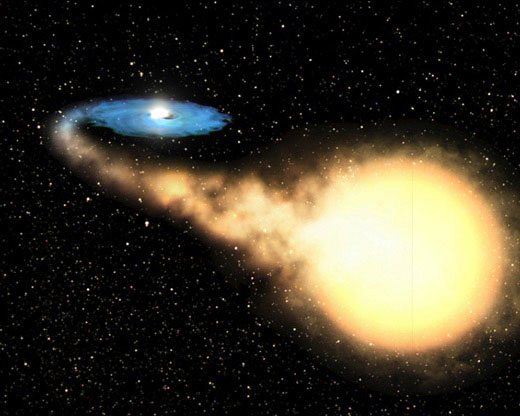The Earth is 7,800 light years away from the black hole V404 Cygni
Researcher Peter Jonker of the SRON Space Research Institute in the Netherlands said the black hole is named V404 Cygni about 7,800 light-years from our Earth.
However, so far, most researchers have always assumed that the distance between a black hole V404 Cygni and Earth is twice that.
Meanwhile, the distance from the Earth to the center of the Milky Way is about 26,000 light-years, while the star closest to the Sun is about 4.2 light-years from Earth.
By measuring radio radiation from black holes to dead stars that created it, researcher Jonker and colleagues calculated the distance to V404 Cygni.
The outer layers of the star are being sucked into the black hole.

Artwork: blackholes.stardate.org
The cloud of rotating dust and gas, creating a plasma disc (the state of matter in which highly ionized substances, the vast majority of atoms and molecules remain only atoms) glow around the black hole before it disappear.
During spinning and creating plasma discs, matter emits a lot of X-rays and radio waves.
Using a radio telescope system called High Sensitivity Array , the researchers measured the change in the black hole's parallax.
The team previously said that it was almost impossible to accurately measure the distance between Earth and the black hole V404 Cygni due to the presence of gas dust in the universe.
Dust can absorb light and cause contamination, which can cause errors of up to 50%. Meanwhile, the error in this new measurement is less than 50%.
A black hole is an area in the universe that has such a large gravitational field that its gravity does not allow any form of matter - including light - to escape its boundary, except the possibility of material loss. out of the black hole thanks to the quantum tunnel effect.
The matter that wants to escape from the black hole must have a escape velocity greater than the speed of light in a vacuum, which cannot happen within the framework of the theory of relativity (where the speed of light in a vacuum is the velocity The largest achievable limit of all physical forms).
Researchers believe that black holes formed from the collapse process into the hearts of stars.
Black holes have at least three times the mass of the Sun. However, many supermassive black holes can have a mass of millions or even billions of solar masses.
This research result has been published in the recent issue of The Astrophysical Journal.
- The most black hole near the Earth is red when
- Scientists have observed 1000 times the material that the Sun has just emerged from a black hole
- Dangerous deadly plasma flows from the black hole
- Observe the black hole with the naked eye
- Stunned to discover about black hole nozzles
- Detecting black holes
- Star 'starving' black hole is a billion light years from Earth
- The discovery of the
- 740 million light years away is a completely different universe of black holes
- Find the missing link on the black hole
- Earth is closer to the black hole than expected
- Discovering a black hole 40 billion times larger than the Sun.
 Van Allen's belt and evidence that the Apollo 11 mission to the Moon was myth
Van Allen's belt and evidence that the Apollo 11 mission to the Moon was myth The levels of civilization in the universe (Kardashev scale)
The levels of civilization in the universe (Kardashev scale) Today Mars, the sun and the Earth are aligned
Today Mars, the sun and the Earth are aligned The Amazon owner announced a secret plan to build a space base for thousands of people
The Amazon owner announced a secret plan to build a space base for thousands of people